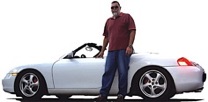
One of the maladies of the Porsche Boxster, Cayman and Carrera platforms is the commonly failing Ignition Switch.
The telltale signs of a failing or failed switch are many and varied, but usually include one, some, or all of the following:
Difficulty in turning the key
Difficulty in inserting or extracting the key
Flickering lights
Intermittent operation of electrical devices such as A/C, radio, interior lights, radiator cooling fans, etc.
Even if it doesn’t sound logical what most likely has failed is the electrical portion of the ignition switch and not the mechanical portion. You don’t have to re-key your car, or replace an expensive part.
The electrical portion of the Ignition Switch is very inexpensive. Prices range from $7.00 to $35.00.
At one time it even had a Porsche Part Number, but eventually was deleted from the Porsche Parts Catalogs and Bins. The good news is that this exact part is also used by Audi and can be purchased at any Audi Dealer with an Audi Part Number: 4A0 905 849 B, or online at a much lower price.
Below you can see the new and the old Ignition Switch. Note the Audi logo on the white one and the part number in the Audi-VW bag.
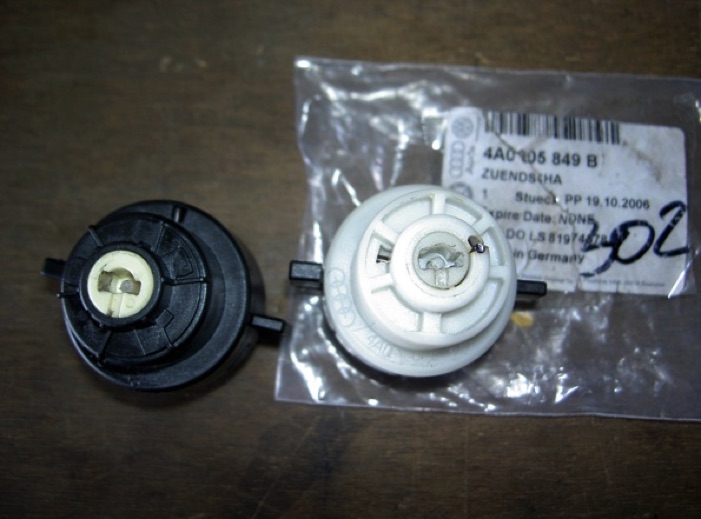
The Ignition Switch is located in the Steering Column Assembly in the dash.
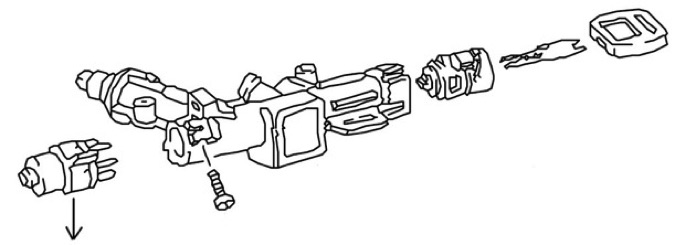
43A0 905 849 B (Audi part number)
Before you start, remove the key from the ignition. You can also disconnect the negative side of the battery for safety. If you do this you may need to have your radio code handy (for older 986s).
IMPORTANT NOTE:
On model year 2004 and newer cars, the ignition
switch was upgraded and is different from the
one described above. The new Audi part
number for this upgraded switch is: 4B0 905 849.
These switches are not interchangeable.
The new version is substantially more expensive.
Tools needed:
• small (jeweler’s) flat-blade screwdriver
• small flashlight
The most difficult part of the whole replacement is positioning yourself so that you can have access to the switch.
Some people have even gone to the extreme of removing the driver’s seat to replace the switch.
I don’t recommend that, having done about one dozen of them I slide into the driver’s footwell head first and face up. The smaller the person, the easier the job. Some people have recruited their smaller better halves to do the job for them, but I’m 6’ 1”/ 250 lbs. and I can slide in there.
You will need to have handy a light source (small flash light that you can hold in your mouth or a fixed small light that can illuminate the work area.
Once you find yourself “comfortable”
find and remove the A/C duct just above
the OBD II port.
You can see the duct (black) and the OBD II
port (magenta) on the right.
To remove the duct, simply grab it and slide
the assembly to one side and pull down.
There are no screws or brackets holding it
in place, just the ducts where it slides into.

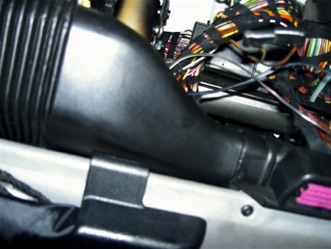
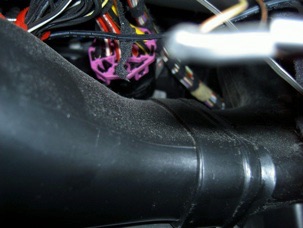
Once you remove the duct, you need to unplug the wiring harness from the back of the ignition switch.
You can see the purple (magenta) connector on the left. It's a multi-pin connector.
To unplug, just pull back from the switch.

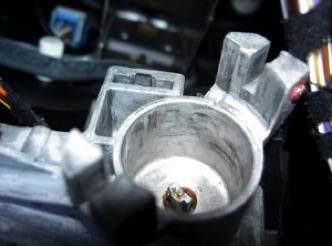
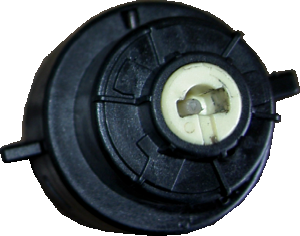



When replacing the new switch, note that the two guides (wings) on the switch need to fit into the notches in the housing (above).
Also, the center notch needs to be aligned with and fit into the keyed center of the housing.
After the switch is in place tighten the two set screws, plug back the wiring harness connector and replace the A/C duct.
Extract yourself out of the footwell and go drive your car.
Happy Boxstering,

REPAIRS
Replace Ignition Switch
This is what the back side of the switch looks
like after unplugging the connector.
Now you need to remove the switch itself.
Note two small screws that must be loosened.
Don’t remove the screws, just loosen them.
You can see the purple thread lock used by
the factory. This thread lock may make it a bit
difficult the first time the screws are loosene
Once the screws have been loosened, you
can simply slide (pull) the bad (electric) ignition switch section out of the mechanical part.
